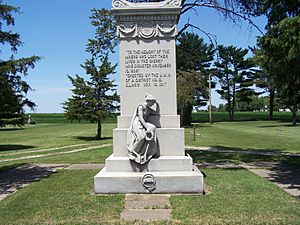1909 Cherry Mine disaster facts for kids
The 1909 Cherry Mine disaster was a terrible fire that happened in a coal mine in Cherry, Illinois. On November 13, 1909, a fire broke out deep underground. Out of about 500 miners working that day, 259 men and boys lost their lives. Some of the boys were as young as 10 years old. This event was one of the worst mining disasters in American history.
Contents
What Was Mining Like Back Then?
In the early 1900s, coal mining was a very dangerous job. Miners risked their lives every single day. In the first ten years of the 20th century, about six miners died each month in coal mines in Northern Illinois. Across the whole U.S., around 2,000 miners died every year between 1905 and 1930.
The Cherry Mine was owned by the St. Paul Coal Company. It opened in 1905 and was considered a very modern mine for its time. By 1909, it was digging up 300,000 tons of coal each year. The mine had two main shafts, which are like big tunnels going straight down. One shaft brought fresh air into the mine and was also used as an escape route. The other shaft had elevators to carry miners and supplies down, and bring coal up. Many of the miners were new to America, having recently arrived from Europe.
The Day of the Fire: November 13, 1909

The Cherry Mine had three layers, or "veins," of coal. On that day, miners were working in two of them. About 300 men were in the second vein, and about 200 were in the deepest, third vein. To reach the third level, miners had to use a different elevator in the escape shaft.
On the morning of November 13, the electric lights in the mine were not working. This was a common problem. When there was no electricity, miners used kerosene lamps for light. A mine car filled with hay for the mules working in the mine somehow caught fire. The fire spread very quickly and became impossible to control. Many miners died from the flames, while others suffocated from the poisonous smoke.
About 45 minutes after the fire started, miners were told to leave the mine. Around 10 to 12 elevator cages full of men reached the surface. Others climbed up the escape shaft. But at about 2:00 p.m., someone decided to reverse the fans that brought air into the mine. This made the fire spread even faster and made things much worse.
Rescue workers bravely went into the mine to try and save lives. But after a cage full of rescuers was lost around 4:00 p.m., the company decided to seal off the mine. This was done to try and cut off the fire's oxygen.
The next day, rescue workers went back into the mine. They wore special helmets with oxygen tanks, as there wasn't much equipment for mine rescues back then. They brought out the bodies of the miners who had died. Then, something amazing happened. A small group of 21 miners had quickly built a wall to protect themselves from the fire. They were found alive eight days later!
What Happened After the Disaster?
In the end, 259 men and boys were killed in the Cherry Mine fire. This terrible event led to many important changes. The U.S. made many new and stronger mining laws and safety rules. The United Mine Workers Union also gained many new members, working to protect miners.
In Illinois, the disaster helped pass the Illinois Workmen's Compensation Act. This law helped workers and their families if someone was hurt or killed on the job. It also played a big part in changing child labor laws in the United States, helping to protect young workers. The Cherry Mine disaster was one of the main reasons the United States Bureau of Mines was created in 1910. This new government agency was formed to improve safety in mines and prevent future tragedies.
Images for kids




